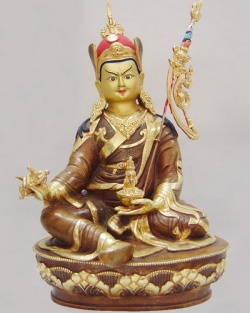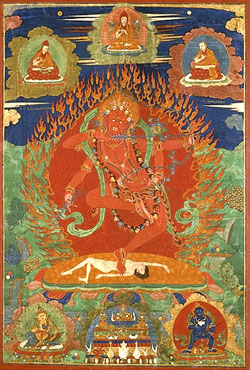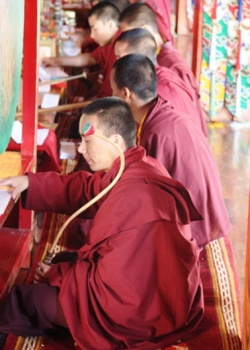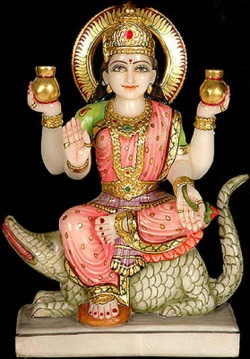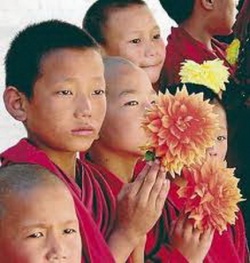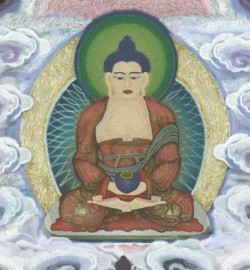The Pāḷi Jhāna Formula
The standard jhāna formula is as follows:
Idha bhikkhave vivicceva kāmehi vivicca akusalehi dhammehi savitakkaṃ savicāraṃ vivekajaṃ pītisukhaṃ paṭhamaṃ jhānaṃ upasampajja vihārati. (DN 22 Mahāsatipaṭṭhāna Sutta)
Here monks, quite secluded from sensual pleasures, secluded from unskillful phenomena, a monk enters and remains in the first jhāna, which includes directed thought and evaluation, as well as joy and pleasure born of seclusion.
We can examine the jhāna formula by comparing the various terms mentioned in it with other occurrences of those and related terms found throughout the suttas.
Quite secluded from sensual pleasures (vivicceva kāmehi)
The first relevant sutta passage is one that occurs in various suttas. For example, AN 6.63 Nibbedhika Sutta states:
Monks, there are these five strands of sensual pleasure (kāmagunā). Forms cognizable by the eye: desirable, lovely, agreeable, endearing, sensually enticing, tantalizing. Sounds cognizable by the ear... odors cognizable by the nose... flavors cognizable by the tongue... tactual objects cognizable by the body: desirable, lovely, agreeable, endearing, sensually enticing, tantalizing.
It is clear that the sensual pleasures referred to in the jhāna formula that are to be withdrawn from prior to entering jhāna, include these five types of external objects referred to as strands of sensual pleasure which are desirable, lovely, agreeable, endearing, sensually enticing, and tantalizing.
There are a couple of points worth mentioning here. Firstly, these five strands of sensual pleasure are all external sensory objects. As such, they correspond to objects within the five external sensory spheres (bāhirāyatanā). Thus, these five sensory objects do not include in-and-out breathing, which is considered internal, nor the internal felt-sense of the body. The strands of sensual pleasure also do not include the recognition of unattractiveness with regard to the thirty-one parts of the body and the nine stages of corpse decomposition. The recognition of unattractiveness is a mental phenomenon.
Secondly, these five strands of sensual pleasure are those external sensory objects that are considered to be desirable, lovely, agreeable, endearing, sensually enticing, and tantalizing. And so it isn’t all sensory objects whatsoever that the meditator need to withdraw from. The meditator needs to withdraw from those external sensory objects which are sensually enticing and tantalizing, as stated here. This withdrawal is facilitated by removing oneself from inappropriate environments for meditation and by abandoning the hindrance of desire for sensual pleasure (kāmacchanda). Both are necessary prerequisites for entering the first jhāna.
As for the relationship between the withdrawal from inappropriate environments and external sensory objects MN 150 Nagaravindeyya Sutta informs us that one practicing for the removal of passion resorts to a remote location:
[T]hose venerable ones resort to remote jungle-thicket resting places in the forest. For there are no forms cognizable by the eye there of a kind that they could look at and delight in. There are no sounds cognizable by the ear there of a kind that they could listen to and delight in. There are no odors cognizable by the nose there of a kind that they could smell and delight in. There are no flavors cognizable by the tongue there of a kind that they could taste and delight in. There are no tactual objects cognizable by the body there of a kind that they could touch and delight in.
Continuing with AN 6.63, we can see that a clear distinction is made between sensual pleasures (kāmā) and the five strands of sensual pleasure (kāmagunā). After defining the five strands of sensual pleasure in the previous passage, the Buddha states:
But monks, these are not sensual pleasures (kāmā). They are called strands of sensual pleasure (kāmagunā) in the discipline of the noble ones.
The resolve of passion is a man’s sensual pleasure.
The world’s beautiful things are not sensual pleasures.
The resolve of passion is a man’s sensual pleasure.
The beauties remain as they are in the world,
While the wise remove desire for them.
Here the Buddha is differentiating sensual pleasures (kāmā) which are the resolve of passion (saṅkapparāga), from the beautiful external sensory objects of that passion, pertaining to which the wise remove desire. The removal of this passionate desire is a major theme of the dhammavinaya. This removal begins with practicing sense restraint (indriya saṃvara), developing the thought of renunciation (nekkhamma vitakka), and is progressively accomplished through the integration of the three path aggregations of ethical conduct (sīla), meditation (samādhi), and discernment (paññā). This eventually culminates in the fruition of the path which includes the complete elimination of the mental outflow of sensual pleasure (kāmāsava).
What these discourses imply is that sensory objects are not inherently “kāma” in and of themselves. MN 13 Mahādukkhakhandha Sutta tells us that the strands of sensual pleasure are the allure of kāma. SN 3.12 Pañcarāja Sutta confirms that the very forms, sounds, odors, flavors, and tactual objects which are agreeable to one person, are disagreeable to another.
Thus external sensory objects are only strands of sensual pleasure if they are agreeable, sensually enticing and tantalizing. And as Itivuttaka 72 informs us, renunciation is the escape from sensual pleasures.
In SN 36.19 Pañcakaṅga Sutta the Buddha tells Ven. Ānanda that whatever pleasure or happiness arises in dependence on the five strands of sensual pleasure is called sensual pleasure. And MN 66 Laṭukikopama Sutta states that this sensual pleasure is:
[A] filthy pleasure, a worldly pleasure, an ignoble pleasure. And I say that this pleasure is not to be cultivated, not to be developed, not to be pursued, that it is to be feared.
Based on these statements it follows that any visible objects of the nine stages of corpse decomposition (DN 22, MN 10) associated with the recognition of unattractiveness, or the visible sphere consisting of “the ridges and hollows, the rivers and ravines, the tracts of stumps and thorns, the mountains and irregular places” associated with the recognition of wilderness (MN 121), which are engaged for developing calm (samatha) in the course of attaining jhāna, cannot be strands of sensual pleasure. If they were, any concomitant pleasure and happiness which would arise in dependence upon these sensory objects would be inappropriate and not worth development (bhāvanā).
This distinction between the five strands of sensual pleasure and the appropriate objects to be employed for mental development is indicated in SN 47.6 Sakuṇagghi Sutta, which clearly differentiates between the five strands of sensual pleasure and the four applications of mindfulness (satipaṭṭhānā). In this discourse one is instructed to avoid wandering into the range of the five strands of sensual pleasure and instead remain in one’s own proper range of the four satipaṭṭhānas:
Do not stray, monks, into what is not your own range and is the domain of others. Māra will gain access to those who stray into what is not their own range and is the domain of others. Māra will get a hold on them.
And what, for a monk, is not his own range and is the domain of others? The five strands of sensual pleasure.... These, for a monk, are not his own range and are the domain of others.
Move, monks, in what is your own range, your own ancestral domain. Māra will not gain access to those who move in their own range, their own ancestral domain. Māra will not get a hold on them.
And what, for a monk, is his own range, his own ancestral domain? The four applications of mindfulness. Which four? Here monks, a monk remains contemplating the body in the body, ardent, fully aware, mindful, having removed covetousness and unhappiness with regard to the world. He remains contemplating feelings in feelings ... mind in mind ... phenomena in phenomena, ardent, fully aware, mindful, having removed covetousness and unhappiness with regard to the world. This, for a monk, is his own range, his own ancestral domain.
With the four applications of mindfulness as the cause for entering and remaining in jhāna, one doesn’t attend to, or partake in any of the five external strands of sensual pleasure. MN 26 Pāsarāsi Sutta states that this allegorically blinds Māra. And as SN 35.115 Dutiyamārapāsa Sutta tells us, if one doesn’t seek delight or grasp onto any sensually enticing phenomenon, then one is said to have escaped from Māra’s snare.
Secluded from unskillful phenomena (vivicca akusalehi dhammehi)
Returning to the jhāna formula, we can next investigate the withdrawal from unskillful phenomena (akusala dhammas). MN 13 Mahādukkhakkhandha Sutta states that bodily misconduct, verbal misconduct, and mental misconduct (kāyena duccarita, vācāya duccarita, manasā duccarita) have sensuality as their cause and source. MN 9 Sammādiṭṭhi Sutta elaborates on these three types of misconduct by giving the standard tenfold list of misconduct:
Taking life is unskillful, taking what is not given is unskillful, sexual misconduct is unskillful, lying is unskillful, abusive speech is unskillful, harsh speech is unskillful, gossip is unskillful, covetousness is unskillful, aversion is unskillful, wrong view is unskillful.
AN 3.102 Paṃsudhovaka Sutta tells us that this level of bodily, verbal, and mental misconduct are coarse defilements. This sutta goes on to state that thoughts of sensual pleasure, thoughts of aversion, and thoughts of harmfulness are considered middling defilements. And thoughts of one’s friends and relatives, thoughts of one’s homeland, and thoughts of not wanting to be disliked are considered subtle defilements. With the abandoning of all of these types of defilement there remain only thoughts related to the dhamma. But one still has to develop one’s mind so that it grows steady inwardly, settles down, and grows unified and composed.
And in SN 45.22 Akusaladhamma Sutta, we read that wrong view, wrong resolve, wrong speech, wrong action, wrong livelihood, wrong effort, wrong mindfulness, and wrong meditative composure are unskillful phenomena. Conversely, the same discourse states that skillful phenomena are right view, right resolve, right speech, right action, right livelihood, right effort, right mindfulness, and right meditative composure. And as we have already seen, right meditative composure (sammāsamādhi) is defined as jhāna.
And so it’s evident that the unskillful phenomena that are to be withdrawn from prior to entering jhāna and while remaining in jhāna are all coarse, middling, and subtle defilements which are unskillful dhammas of body, speech, and mind. And this is accomplished by developing the noble eightfold path.
The Hindrances: Five Things Abandoned in the First Jhāna
Before we investigate the jhāna formula any further, we can take a look at what specifically is abandoned in order to enter and remain in the first jhāna, namely, the five hindrances (pañcanīvaraṇā). MN 43 Mahāvedalla Sutta tells us:
Five factors are abandoned in the first jhāna.... Here, when a monk has entered the first jhāna, desire for sensual pleasure (kāmacchanda) is abandoned, aversion (byāpāda) is abandoned, lethargy and drowsiness (thīnamiddha) is abandoned, restlessness and anxiety (uddhaccakukkucca) is abandoned, doubt (vicikicchā) is abandoned.
MN 39 Mahāssapura Sutta elaborates:
Here monks, a monk resorts to a secluded dwelling: a forest, the shade of a tree, a mountain, a glen, a hillside cave, a charnel ground, a jungle grove, an open space, a heap of straw. After his meal, returning from his alms round, he sits down, crosses his legs, holds his body upright, and brings mindfulness to the fore.
Abandoning covetousness with regard to the world [a synonym for the first hindrance), he dwells with a mind devoid of covetousness. He cleanses his mind of covetousness. Abandoning aversion and anger, he dwells with a mind devoid of aversion, sympathetic to the welfare of all living beings. He cleanses his mind of aversion and anger. Abandoning lethargy and drowsiness, he dwells with a mind devoid of lethargy and drowsiness, mindful, fully aware, clearly percipient. He cleanses his mind of lethargy and drowsiness. Abandoning restlessness and anxiety, he dwells undisturbed, his mind inwardly stilled. He cleanses his mind of restlessness and anxiety. Abandoning doubt, he dwells having crossed over doubt, with no perplexity with regard to skillful phenomena. He cleanses his mind of doubt.
The abandoning of the five hindrances are a necessary but not sufficient condition for the attainment of the first jhāna. The arising of the five factors of the first jhāna are also necessary. With both of these conditions satisfied — the abandoning of the five hindrances and the arising of the five jhāna factors — the meditator has fulfilled the necessary and sufficient conditions of the first jhāna.
The Jhāna Factors: Five Phenomena the First Jhāna Is Endowed With
Returning to the jhāna formula, we can take a look at the phenomena which are present in the first jhāna. MN 43 Mahāvedalla Sutta tells us that the first jhāna is endowed with five factors:
The first jhāna has five factors. Here, when a monk has entered the first jhāna, there occurs directed thought (vitakka), evaluation (vicāra), joy (pīti), pleasure (sukha), and singleness of mind (cittekaggatā). That is how the first jhāna has five factors.
With directed thought and evaluation (savitakkaṃ savicāraṃ)
In the thought-world of the Pāḷi discourses, directed thought (vitakka) is closely related to resolve (saṅkappa). MN 78 Samaṇamuṇḍika Sutta tells us that unskillful resolves cease in the first jhāna and that skillful resolves (kusalā saṅkappā) consisting of the resolve of renunciation (nekkhammasaṅkappa), the resolve of non-aversion (abyāpādasaṅkappa), and the resolve of harmlessness (avihiṃsāsaṅkappa) don’t cease until the second jhāna. This provides some context as to the meaning and significance of directed thought and evaluation (vicāra) in the standard jhāna formula. The Samaṇamuṇḍika Sutta states:
And what are skillful resolves? Being resolved on renunciation, on non-aversion, on harmlessness. These are called skillful resolves. What is the cause of skillful resolves? Their cause, too, has been stated, and they are said to be recognition-caused. Which recognition? — for recognition has many modes and permutations. Any renunciation-recognition, non-aversion-recognition, or harmlessness-recognition: That is the cause of skillful resolves.
Now where do skillful resolves cease without trace? Their stopping, too, has been stated: There is the case where a monk, with the stilling of directed thought and evaluation, enters and remains in the second jhāna, which has internal serene-clarity and unification of mind free from thought and evaluation, and has joy and pleasure born of composure. This is where skillful resolves cease without trace.
Of course, any experienced meditator with proficiency in attention training knows that adventitious discursive thinking inhibits the calming of the mind. And so the directed thought and evaluation of the first jhāna is more refined than adventitious discursiveness. It’s the skillful application of the cognitive faculty to a particular theme of focus, without lapsing from that focus. To be effective, directed thought and evaluation must necessarily work in concert with the concomitant application of mindfulness and sustained attention. In this way, directed thought and evaluation help to serve as causal factors for the abandoning of the hindrances, the arising of the other jhāna factors, as well as aiding in the maintenance of the jhāna factors once the first jhāna has been successfully entered.
This understanding of directed thought and evaluation finds support in the early para-canonical Peṭakopadesa, which in it’s analysis of the jhāna factors is closer to the suttas than are the definitions given in the Abhidhammapiṭaka. Regarding directed thought and evaluation in the first jhāna formula, Peṭakopadesa 7.72 offers the following word-commentary:
Here, for fulfilling non-passion he thinks the thought of renunciation. Here, for fulfilling non-aggression he thinks the thought of non-aversion. Here, for fulfilling non-delusion he thinks the thought of harmlessness.
Here, for fulfilling non-passion he is secluded from sensual pleasures. Here, for fulfilling non-aggression and fulfilling non-delusion he is secluded from unskillful phenomena. And so he enters and remains in the first jhāna, which includes directed thought and evaluation, as well as joy and pleasure born of seclusion.
Directed thought: There are three kinds of directed thought, namely the thought of renunciation, the thought of non-aversion, and the thought of harmlessness.
Here, directed thought is the first instance while evaluation is the evaluation of what is thereby received.
Just as when a man sees someone approaching in the distance he does not yet know whether it is a woman or a man, but when he has received [the recognition) that “it is a woman” or “it is a man” or that “it is of such color” or that “it is one of such shape,” then when he has thought this he further scrutinizes, “How then, is he ethical or unethical, rich or poor?” This is examination. With directed thought he fixes. With examination he moves about and turns over [what has been thought).
And just as a winged bird first accumulates [[[Wikipedia:speed|speed]]] and then accumulates no more [[[Wikipedia:speed|speed]] when gliding], so too, directed thought is like the accumulation, and evaluation is like the outstretched wings which keeps preserving the directed thought and evaluation....
Directed thought is like a text-reciter who does his recitation silently. Evaluation is like him simply contemplating it. Directed thought is like a lack of full comprehension (apariññā). Evaluation is like full comprehension (pariññā). Directed thought is the analytical understanding of language (niruttipaṭisambhidā) and the analytical understanding of knowledge (paṭibhānapaṭisambhidā). Evaluation is the analytical understanding of dhamma (dhammapaṭisambhidā) and the analytical understanding of meaning (atthapaṭisambhidā). Directed thought is the mind’s skill in pleasantness. Evaluation is the mind’s skill in endeavor. Directed thought is about this being skillful, this unskillful, about this to be developed, this to be abandoned, this to be verified. Evaluation is like the abandoning, the development, the verification.
And so, in light of the above sutta and early commentarial passages we can see that narrowly interpreting vitakka and vicāra as “initial and sustained attention” or “initial and sustained intention” represents a later semantic shift in the meaning of these terms in the context of jhāna which isn’t supported by their occurrence in the suttas and early commentarial sources such as the Peṭakopadesa.1 Moreover, in the list of mental factors given in MN 111, which the meditator can discern individually as they occur by employing clear seeing (anupadadhammavipassanā) while abiding in jhāna, we find vitakka as well as attention (manasikāra) and intention (cetanā) listed. If any of these three terms were synonyms for the same mental referent then there would be no way to differentiate between them, and it would have been pointless for this discourse to mention all three phenomena.
Joy and pleasure born of seclusion (vivekajaṃ pītisukhaṃ)
The discourses differentiate between carnal joy and pleasure (sāmisā pīti and sukha) and non-carnal joy and pleasure (nirāmisā pīti and sukha). SN 36.31 Nirāmisa Sutta tells us that carnal joy and pleasure arise in dependence on the five strands of sensual pleasure, while non-carnal joy arises in the first two jhānas and non-carnal pleasure arises in the first three jhānas.
SN 48.40 Uppaṭipāṭika Sutta states that the pain faculty (dukkhindriya) ceases completely in the first jhāna, the unhappiness faculty (domanassindriya) ceases completely in the second jhāna, the pleasure faculty (sukhindriya) ceases completely in the third jhāna, and the happiness faculty (somanassindriya) ceases completely in the fourth jhāna.
SN 48.37 Dutiyavibhaṅga Sutta informs us that the pleasure and pain faculties are born of body contact (kāyasamphassaja), whereas the happiness and unhappiness faculties are born of mind contact (manosamphassaja).
Taking all of the above passages into consideration we can deduce that the non-carnal joy of the first jhāna is mental pleasure (cetasika sukha, i.e. somanassa) born of mind contact, and the non-carnal pleasure of the first jhāna is bodily pleasure (kāyika sukha) born of body contact.
This reading of these sutta sources accords with Peṭakopadesa 7.72:
The twofold bodily and mental pain does not arise in one steadied in directed thought and evaluation, and the twofold bodily and mental pleasure does arise. The mental pleasure thus produced from directed thought is joy, while the bodily pleasure is bodily feeling.
This understanding is also supported by the Vimuttimagga. The author of the Vimuttimagga was knowledgeable of and quotes from the Uppaṭipāṭika Sutta, the Paṭisambhidāmagga, the Vibhaṅga, and the Peṭakopadesa. And when commenting on the bathman simile for the first jhāna (e.g. DN 2, MN 119, etc.) he explains:
Just as the bath-powder when inside and outside saturated with moisture, adheres and does not scatter, so the body of the meditator in the first jhāna is permeated with joy and pleasure from top to bottom, from the skullcap to the feet and from the feet to the skullcap, skin and hair, inside and outside. And he dwells without falling back. Thus he dwells like a Brahma god.
[Q.] Joy (pīti) and pleasure (sukha) are said to be formless phenomena (arūpa-dhamma). How then can they stay permeating the body?
[A.] Name (nāma) depends on form (rūpa). Form depends on name. Therefore, if name has joy, form also has joy. If name has pleasure, form also has pleasure.
Again, form born from joy causes tranquility of body, and when the entire body is tranquilized there is pleasure due to the tranquility of form. Therefore there is no contradiction.
To this we can add a couple of more points. First, due to the presence of directed thought and evaluation in the first jhāna, intermittent occurrences of mental unhappiness can still arise, as indicated in SN 48.40. Thus the singleness of mind of the first jhāna isn’t necessarily as unified as in the higher jhānas. Secondly, when the meditator is steadied in the first jhāna, all of the jhāna factors work together to maintain what DN 9 calls an actual refined recognition of joy and pleasure born of seclusion (vivekajapītisukhasukhumasaccasaññā). Thus, while the singleness of mind of the first jhāna may not be as unified as in the higher jhānas, it is still a very refined samādhi. It takes considerable mental development in order to be able to successfully induce and maintain this level of heightened mind (adhicitta).
Singleness of mind (cittekaggatā)
Although singleness of mind isn’t mentioned in the standard formula of the first jhāna, likely because it isn’t as prominent here as in the second jhāna, nevertheless, MN 43 lists it as one of the five jhāna factors. Moreover, MN 44 Culavedalla Sutta, defines meditative composure (samādhi) as singleness of mind:
Singleness of mind (cittassa ekaggatā) is meditative composure, friend Visakha; the four applications of mindfulness are its causes (nimitta); the four integral exertions are its requisites; and any cultivation, development, and pursuit of these qualities is its development.
It’s also worth noting that the nimittas of meditative composure are given as the four applications of mindfulness.
Similarly, the faculty of meditative composure (samādhindriya) is defined as the attainment of singleness of mind by a noble disciple (ariyasāvaka) who has attained the path. SN 48.10 Indriyavibhaṅga Sutta:
And what is the faculty of meditative composure? Here monks, a noble disciple, making letting go his object, gains composure, gains singleness of mind. Quite secluded from sensual pleasures, secluded from unskillful phenomena, he enters and remains in the first jhāna....
And this definition of the faculty of meditative composure naturally includes jhāna as the eighth component of the noble eightfold path.
Notes
It is also worth noting that Sautrāntika and Yogācāra commentators consistently define vitakka and vicāra as two types of “mental discourse” (manojalpa, lit: “mind-talk”). For example, Vasubandhu’s Pañcaskandhaprakaraṇa defines vitakka as “mental discourse which investigates” (paryeṣako manojalpa) and vicāra as “mental discourse which reflects” (pratyavekṣako manojalpa). Vitakka is considered to be coarse (cittsyaudārikatā) and vicāra comparatively more subtle (cittsyasūkṣmatā).
